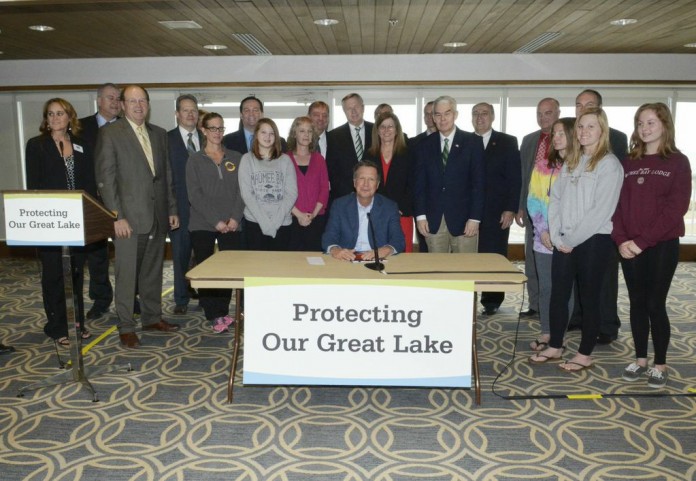(This is a developing story. Expect updates. 7:50 a.m., July 12.)
SALEM, Ohio — Ohio Gov. John Kasich signed an executive order July 11 that recommends eight northwestern watersheds be considered under state law as “Watersheds in Distress,” due to high nutrient levels, including phosphorous, which are fueling the harmful algal bloom in Lake Erie.
The watersheds include Platter Creek, Little Flat Rock Creek, Little Auglaize River, Eagle Creek, Auglaize River, Blanchard River, St. Marys River, and Ottawa River.
“We’ve done a lot to ensure the health of Lake Erie, Ohio’s crown jewel, including investments of more $3 billion since 2011 to improve water quality in the lake and its watershed,” Kasich said, in a released statement. “But it’s clear that more aggressive action is needed, especially to reduce or eliminate the algae blooms that have marred the western basin for years. This executive order is intended to kick those efforts into overdrive.”
Nutrient management requirements
The order instructs the Ohio Soil and Water Conservation Commission to review the watersheds for the “distressed” designation, and for the Ohio Department of Natural Resources, EPA, and state agriculture department to recommend a rules package that “establishes nutrient management requirements for all agricultural nutrient sources.”
The “distressed” designation could be removed only after the director of agriculture determines the “sustained recovery, restoration and mitigation of factors leading to the original designation.”
After signing his executive order, Kasich also signed the Clean Lake 2020 Plan, which was unanimously approved by the Legislature and allocates $36 million for farm-related conservation measures intended to improve water quality.
Kasich had hoped the Legislature would include language to declare watersheds in distress, but because no one would take up the measure, he decided on an executive order.
Farm groups critical
Farm groups criticized Kasich in a statement June 28, in which they accused him of “ignoring the voluntary conservation efforts, scientific research and mandatory compliance efforts Ohio farm families are implementing to improve water quality.”
The criticism continued immediately following his executive order. The Ohio Corn and Wheat Growers Association, along with the Ohio Soybean Association, said the governor’s plan does not reflect the work farmers are already doing, and will not necessarily solve the problem.
“Although Gov. Kasich has worked productively with our farmers in the past, the administration is now acting without our input,” said OSA Executive Director Kirk Merritt, in a released statement. “Farmers are willing to do what needs to be done to solve this problem, but now we’re not even being invited to the table.”
The Ohio Farm Bureau Federation criticized the governor for not being transparent and working with the ag community.
“We can’t even react to the specific regulations he’s proposing; we haven’t seen them,” said Adam Sharp, executive vice president of Ohio Farm Bureau.
According to the Farm Bureau, Kasich’s order “has no realistic recognition” of the time nor the financial or educational resources required for farmers to comply.
Regulations created under the order “may conflict with multiple layers of existing regulation.” There are also significant concerns about the science applied, the processes through which the order will be enacted and the specific authorities of the multiple state agencies charged with carrying out the order.
James Zehringer, director of the Department of Natural Resources, said the “distressed” designation worked successfully to improve Ohio’s Grand Lake St. Marys, beginning in 2011, and he’s confident it will help with Lake Erie, too.
“As a farmer who lived and farmed just miles from Grand Lake St Marys … I understand the concerns of the agricultural commmunity and what they’re experiencing right now,” Zehringer said, adding that “nutrient management plans work” and commending the governor on “another step in the right direction.”
Who’s to blame?
Kasich said it was agriculture’s fault for not being at the table and doing more to clean up the lake. He said an executive order is a legal tool he can use when necessary, but that the Legislature could nullify it if it’s off the mark.
He also said the biggest threat to his executive order would be “special interest groups” who may seek to “water it down.”
“As we go through this process, if there is some boneheaded provision in what we want to do with farmers and they want to restore common sense where they think there is none, we’re open to that — we’re for that,” Kasich said. “But they don’t say no, never, no how. We gave people a long time to come to the table and get this done and they were not there.”
Background
The governor sought an impairment designation for the western part of Lake Erie in March, and his cabinet has increased the pressure on agriculture since that time, with new reports from the EPA saying that not enough progress is being made.
The state is set to learn today, how severe this year’s harmful algal bloom will be, during the annual harmful algal bloom forecast, provided by the National Oceanic Atmospheric Administration and researchers at Ohio State University.
Farm groups and researchers with Ohio State also continue to explore effective farming practices to control nutrients, and farm groups contend that not enough answers are known to require additional regulations.
The Ohio AgriBusiness Association is planning a field day next week, to demonstrate and discuss the latest findings in on-farm research at the Blanchard River Demonstration Farms. Researchers from OSU and the U.S. Department of Agriculture will both present.
Related Coverage:
- Ohio to declare western portion of Lake Erie impaired (March 22, 2018).
- Ohio EPA addressing river nutrients (April 11, 2018).
- Ohio lawmakers review fertilizer bill (June 7, 2018).










